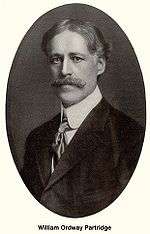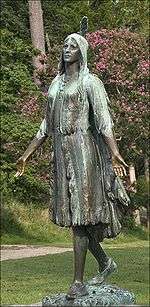William Ordway Partridge
William Ordway Partridge (April 11, 1861 – May 22, 1930) was an American sculptor whose public commissions can be found in New York City and other locations.

Life and career
William Partridge was born in Paris to American parents descended from the Pilgrims in Massachusetts; his father was a representative of A.T. Stewart. At the end of the reign of Napoleon III, Partridge travelled to America to attend Adelphi Academy in Brooklyn and Columbia University (graduated 1883) in New York. After a year of experimentation in theatre, he went abroad to study sculpture. During a brief stint in the Paris studio of William-Adolphe Bouguereau, he formed a close friendship with the neo-Gothic architect Ralph Adams Cram on his 1887 trip.[1] He knew the young Bernard Berenson in Florence, where he studied in the studio of Galli, and Rome, in the studio of Pio Welonski (1883–1885).[2]
His published work includes articles on aesthetics and several art history books including Art For America (1894), The Song Life of a Sculptor (1894), and The Technique of Sculpture (1895). He also wrote poems and published the verse novels Angel of Clay (1900) and The Czar's Gift (1906).[3]
Aside from his public commissions, his work consisted mostly of portrait busts. In 1893 eleven of his works were displayed at the World's Columbian Exposition, Chicago, according to the official catalog of the Fine Arts Building at the fair, where he exhibited sculptures of Alexander Hamilton and William Shakespeare[4] as well as portraits. In this same catalog Partridge was listed as living in Milton, Massachusetts. He maintained homes and studios in both Milton and New York. Among his studio assistants on West 38th Street in New York was Lee Lawrie.
Partridge went on to lecture at Stanford University in California, and assumed a professorship at Columbian University, now George Washington University, in Washington, D.C.
His life-size statue of the Native American princess Pocahontas was unveiled in Jamestown, Virginia in 1922. Queen Elizabeth II viewed this statue in 1957 and again on May 4, 2007, while visiting Jamestown on the 400th anniversary of the founding of the first successful English colonial settlement in America. On October 5, 1958, a replica of the Pocahontas statue by Partridge was dedicated as a memorial to the princess at the location of her burial in 1617 at St. George's Church in Gravesend, England. The Governor of Virginia presented the replica statue as a gift to the British people.
Partridge died in Manhattan, New York on May 22, 1930.
Selected works

A considerable amount of Partridge's statuary remains on public display in New York City and other locations:
- Samuel J. Tilden, on Riverside Drive at 113th Street.
- Statue of Thomas Jefferson (1914), in front of Journalism Hall at Columbia University.
- Thomas Jefferson, New-York Historical Society, 1901.[5]
- Alexander Hamilton, Hamilton Grange, New York, (1892.[6]) This standing figure was commissioned by the Hamilton Club of Brooklyn and having been exhibited at the World's Columbian Exposition, stood in front of the Club's premises in Brooklyn Heights, 1893–1936, when it was removed to its present location.[7] A 1908 replica stands in front of Hamilton Hall, Columbia University.[8]
- Edward Everett Hale, bust, Union League Club of Chicago. (Appleton's Cyclopaedia)
- A bust of Dean John Howard Van Amringe at Columbia University.
- Nathan Hale[9]
- The marble memorial plaque showing the likeness of James Smithson in the crypt room where Smithson's tomb is located, inside The Castle Building of the Smithsonian Institution, Washington, D.C., 1900. The original of this work is in Genoa, Italy, where Smithson died.[10]
- The Resurrection, marble bas-relief for the National Cathedral, Washington, D.C., 1902.
- The marble Pietà at St. Patrick's Cathedral.
- The equestrian statue of General Ulysses S. Grant, commissioned by the Union Club of Brooklyn and unveiled April 27, 1896, in Grant Square, at Bedford Avenue and Dean Street, Crown Heights, Brooklyn.
- The bust of Theodore Roosevelt at the Republican Club.
- The marble Peace Head at the Metropolitan Museum of Art, New York.
- Anne's Tablet, memorial to Constance Fenimore Woolson, Mackinac Island, Michigan
- Pietà, St. Patrick's Cathedral, New York, transept.
- The Samuel H. Kauffman Memorial ca. 1921, Rock Creek Cemetery, Washington, D.C. A seated bronze figure on a marble exedra with bronze bas-reliefs of the Seven Ages of Man after Shakespeare.[11]
- The Joseph Pulitzer Memorial (1913) in Woodlawn Cemetery, The Bronx.[12] Seated mourning figure.
- Memory 1914. Memorial Art Gallery, Rochester, New York.[13]
Affiliations

- Architectural League of New York
- Sons of the American Revolution
- Veteran Corps of Artillery, State of New York
- American Institute of Architects (honorary)
- Royal Society of Arts, London
- He was also a member of the literary and artistic Lotos Club, New York
Notes
- Douglass Shand-Tucci, Boston Bohemia, 1881-1900: Ralph Adams Cram: Life and Architecture (University of Massachusetts Press) 1996:59.
- Encyclopædia Britannica 1911: 'William Ordway Partridge"; Smithsonian American Art Museum
- "PARTRIDGE, William Ordway". Who's Who in New York City and State. Vol. 4. 1909. p. 1020.
- The Shakespeare remained in Lincoln Park, Chicago. (Appleton's Cyclopaedia)
- http://www.nyhistory.org/node/21949
- Inscribed 1892 on base.
- Dianne Durante, "Alexander Hamilton"
- Dolkart, Andrew S. (1998). Morningside Heights: A History of its Architecture and Development. Columbia University Press. pp. 412-413 (footnote 62). ISBN 978-0-231-07850-4. OCLC 37843816. Dolkart notes that W. Ordway Partridge also produced the Class of 1885 Sundial, in a setting by Charles Follen McKim, the Thomas Jefferson in front of Journalism Hall (1914) and the Van Amringe Memorial in the Van Amringe Quadrangle (1918-22)
- Partridge published a poem and essay, with a vita of Hale co-written by George Cary Eggleston, Nathan Hale, The Ideal Patriot, 1902, in part to generate interest for his sculpture, which occupied a chapter entitled "The creation of an ideal work."
- Partridge, William Ordway, The Works in Sculpture of William Ordway Partridge, M.A., John Lane Company, New York, 1914 p. 35
- "Cultural Tourism: The Kauffman Memorial". Archived from the original on October 9, 2007. Retrieved 2017-12-20.CS1 maint: BOT: original-url status unknown (link)
- Public Art in The Bronx/
- Seeing America: Painting and Sculpture from the Memorial Art Gallery 44
Sources
External links
| Wikimedia Commons has media related to William Ordway Partridge. |
- Works by or about William Ordway Partridge at Internet Archive
- Chisholm, Hugh, ed. (1911). . Encyclopædia Britannica (11th ed.). Cambridge University Press.
- William Ordway Partridge at Find a Grave
- AskArt.com:"William Ordway Partridge"
- Smithsonian American Art Museum: "William Ordway Partridge"
- (George Eastman House) Sculptures by Ordway, photographed by William Vander Weyde
- Smithsonian Archives: W. Ordway Patridge papers
References
- Appleton's Cyclopaedia of Armerican Biography